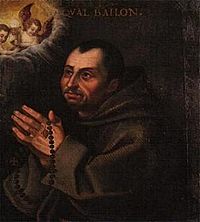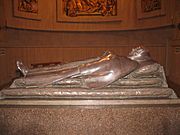Paschal Baylón facts for kids
Quick facts for kids SaintPaschal Baylón O.F.M. |
|
|---|---|
 |
|
| Religious | |
| Born | 16 May 1540 Torrehermosa, Aragon Spain |
| Died | 17 May 1592 (aged 52) Villarreal, Aragon Kingdom, Spain |
| Venerated in | Roman Catholic Church |
| Beatified | 29 October 1618, Saint Peter's Basilica, Papal States by Pope Paul V |
| Canonized | 16 October 1690, Saint Peter's Basilica, Papal States by Pope Alexander VIII |
| Feast | 17 May |
| Attributes |
|
| Patronage |
|
Saint Paschal Baylón (born May 16, 1540 – died May 17, 1592) was a Spanish Catholic religious brother. He was part of the Franciscan Order.
When he was young, Paschal worked as a shepherd with his father. He always wanted to join a religious order. He was turned down once, but later became a Franciscan brother. He was known for living a very simple and strict life. He also showed great love and care for people who were sick.
Paschal traveled to France to share his faith. There, he faced danger from a crowd. He was especially known for his deep love and devotion to the Eucharist.
The Church began the steps to make him a saint. He was declared "blessed" in 1618. Later, Pope Alexander VIII officially made him a saint on October 16, 1690.
His Early Life
Paschal Baylón was born on May 16, 1540, in Torrehermosa, Spain. This day was the feast of Pentecost. His parents, Martin and Elizabeth Jubera Baylón, were poor but very religious farmers. He was named Paschal because it was the custom to name a child after the saint or feast day of their birth. He had one brother and two sisters.
From age seven to twenty-four, Paschal worked as a shepherd. During this time, he was a good influence on his friends.
Someone gave him a book called the Little Office of the Blessed Virgin Mary. He learned to read by asking people for help with the words. Paschal always shared his own food with the poor. He had no other way to help them. To help his family, Paschal worked for other farmers, tending their sheep.
Some of his shepherd friends used bad language and often argued. But they learned to be quiet when Paschal was around. They respected his kind nature and good behavior. He was also very honest. He even offered to pay farmers if his sheep accidentally damaged their crops.
Becoming a Friar
When Paschal first spoke about wanting to join a religious life, people suggested rich monasteries. But he said, "I was born poor and I want to die poor and living a simple life."
At first, the Franciscans did not let him join because of his age. So, he went back to being a shepherd. In 1564, he finally joined the Reformed Franciscans as a religious brother. He began his training period on February 2, 1564. He made his official vows on February 2, 1565, at the Saint Joseph convent in Orito. People encouraged him to become a priest, but he felt that was not what God wanted for him.
Paschal owned only one religious robe, and it was always worn out. He walked without sandals, even in the snow. He adapted to all places and seasons. His jobs included cooking, gardening, and collecting donations for the friars. As the porter, he was in charge of helping the poor people who came to the friars' door. Paschal became known for his great humility, kindness, and generosity.
He spent much of his life in quiet prayer and thought, even while working. He often had deep spiritual experiences. Some nights, he would spend hours praying silently before the altar. But he did not want to become famous for his religious life. Once, while traveling through France, he spoke about his belief in the Real Presence of Christ in the Eucharist. Because of this, he almost died at the hands of an angry crowd.
Paschal became sick and died on May 17, 1592. This day is now celebrated as his feast day.
Honoring Saint Paschal
His tomb in Villarreal quickly became a place where people went to pray. Many miracles were reported at his tomb. Pope Paul V declared him "blessed" on October 29, 1618. Later, Pope Alexander VIII made him a saint on October 16, 1690.
In 1730, an Indigenous person in Guatemala said they saw a vision of Saint Paschal as a skeleton wearing a robe. This vision led to a special tradition called San Pascualito.
Pope Leo XIII called Saint Paschal the "seraph of the Eucharist" in 1897. He also made him the patron saint of Eucharistic congresses and related groups. In art, Saint Paschal is often shown wearing the Franciscan habit and holding a monstrance. This shows his strong devotion to the Holy Eucharist. Pope John XXIII named Saint Paschal the patron saint for the Segorbe diocese on May 12, 1961.
During the Spanish Civil War, his grave was damaged. Some people burned his relics, which are parts of a saint's body or belongings. However, some relics remained. These remaining relics were later moved in front of King Juan Carlos I on May 12, 1992.
Places Named After Him
Many places are named after Saint Paschal Baylón, including:
- San Pascual, Batangas, Philippines
- Saint-Pascal, Quebec, Canada
- Saint-Pascal Baylon, Ontario, Canada
- San Pascual, Burias Island, Masbate, Philippines
- San Pascual, Obando, Bulacan, Philippines
- San Pascual Baylon, Guinarona Dagami, Leyte
- San Pascual Baylon, Tinambac, Camarines Sur
See also
 In Spanish: Pascual Baylón para niños
In Spanish: Pascual Baylón para niños
- Saints of Obando
- Sanctuary of St. Paschal Baylon


